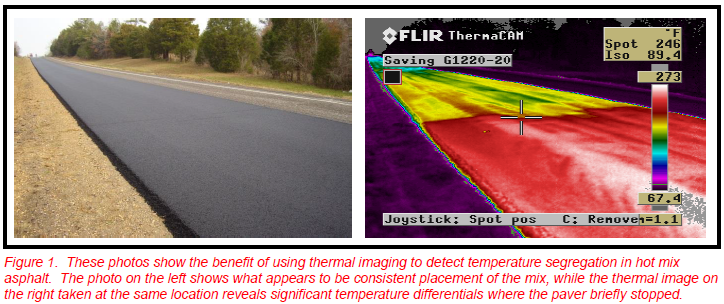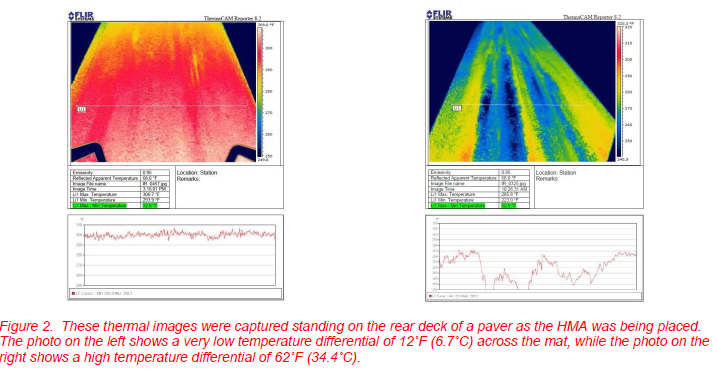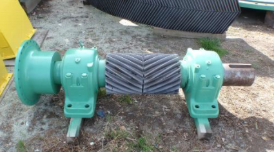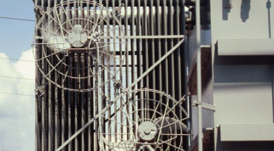Evaluation of Hot Mix Asphalt Material Remixing Devices
InfraMation 2015 Application Paper Submission
Jeff Benefield, PE
Alabama Department of Transportation
ABSTRACT
The vast majority of Alabama’s roadways are paved with bituminous asphalt mixes. Commonly called “hot mix asphalt” (HMA), the mix components must be heated and blended at offsite plants and trucked to the jobsite for placement. During construction of HMA pavements, the highest quality is achieved when the entire operation is consistent – plant production, reliable delivery of the mix, constant paver speed, and continuous compaction by the rollers. A crucial part of these various processes is the need to place the mix at consistent temperatures. Critical heat is lost during HMA shipment from the plant, especially on the top and sides of the mass of mix in the haul vehicle. Re-mixing or re-blending of the HMA prior to placement has proven to be very beneficial and can be accomplished by “material remixing devices”, or MRDs, that operate as a separate piece of equipment between the haul vehicles and the paver. The purpose of this paper is to describe how the Alabama Department of Transportation (ALDOT) evaluates MRDs to insure that these devices have sufficient remixing capability.
INTRODUCTION
ALDOT began requiring the use of MRDs in the year 2000 on interstates and other high traffic routes. This requirement has been expanded over the years to include the majority of roadways, with a few exceptions. When ALDOT initially began requiring MRDs, only two brands were available – the Roadtec Shuttlebuggy and the Blaw Knox MC 330. These two devices were considered acceptable at the time and were grandfathered into ALDOT’s specifications 1 without any field evaluation. Other equipment suppliers soon introduced their own MRDs into the HMA market. Subsequently, contractors began requesting permission to use these alternative models on Alabama’s construction projects, which prompted ALDOT to develop a procedure utilizing thermal imaging for evaluating the effectiveness of the MRD’s operation.

SEEING THE UNSEEN WITH THERMAL IMAGING
HMA mixes are produced, in general, in the range of 275˚F – 350˚F (135˚C – 176.7˚C). At such high temperatures, working around this material simply feels “hot”, with no indication, visually or otherwise, that relatively cooler areas could possibly exist. The use of thermal imaging cameras has proven otherwise and has opened up a new world to the inspection and construction process.
An HMA mix may have a satisfactory appearance to the naked eye at the time of placement, only to begin showing signs of distress (potholes, raveling, etc.) a short time later. These failures, which can occur weeks, months, or even years later, are often caused by aggregate and temperature segregation within the mix that result in lower densities and water intrusion – both spelling trouble for the pavement. Since ALDOT does not require warranties on HMA pavements (for various reasons), the cost of repairs and lost service life of the pavement usually falls to the taxpayer.
EVALUATIONS USING INFRARED TECHNOLOGY
In 2008, after learning that other DOTs were successfully utilizing thermal imaging for HMA inspection and quality control, ALDOT purchased a FLIR P640 and developed Procedure 424-042, Material Remixing Device Evaluation, for use in evaluating the current and recently proposed MRDs. ALDOT’s procedure requires the contractor to place a minimum of 2,000’ (610m) long HMA test section, while an evaluation team captures thermal images on 50’ (15.2m) longitudinal intervals of the typically 12’ (3.7m) wide HMA mat. The operator and thermal camera are normally stationed on the back deck of the paver, a convenient vantage point from which to capture thermal images at a consistent distance behind the paver.
Once the 2,000’ (610m) test section is imaged, FLIR’s ThermaCam Reporter software is used to develop a template by which the temperature differential at each interval, measured transversely across the mat, can be determined. The tools within the software make this process fairly simple. The 40 or so differentials are then averaged yielding the overall differential for the entire test section.
For the remixing device to be deemed acceptable, the overall differential must not exceed the maximum of 18˚F (10˚F) set by the procedure. As ADLOT began evaluations, some MRDs were not successful in meeting this requirement, but the failures were often attributed to poor paving practices, equipment malfunctions, or interruption in the mix supply by delivery vehicles. Re-trials were allowed, corrections made where needed, and by July 2011, three additional models of MRDs had been evaluated and approved for use on ALDOT’s construction projects: the Cedar Rapids / Terex CR 662, the Weiler E 1250, and the Weiler E 2850.

SUMMARY
Thermal imaging has shown great promise and value as an inspection tool for hot mix asphalt construction operations. ALDOT has been pleased with the value and knowledge gained through its use of the FLIR P640 camera as a means to evaluate the capability of various MRDs. Research conducted by the National Center for Asphalt Technology on behalf of ALDOT has provided even more information in this arena. This research, titled Evaluation of Thermal Segregation 3, recommended that ALDOT continue its use of thermal imaging as an inspection tool. More sophisticated thermal image recording devices have come available on the market in recent years, and ALDOT is currently exploring pilot projects that will provide for further use of this technology for HMA placement.
REFERENCES
1) ALDOT Standard Specifications; Article 410.03, Construction Requirements
2) ALDOT Procedure 424 – 06; Material Remixing Device Evaluation Procedure; Revised April 10, 2009
3) Evaluation of Thermal Segregation; ALDOT Research Project 930-737; National Center for Asphalt Technology; Don Watson and Sergio Fernandez Cerdas; June 2012
ACKNOWLEDGEMENTS
The author wishes to thank the Infrared Training Center and the Alabama Department of Transportation for the opportunity to present this important topic. Gratitude is also extended to the National Center for Asphalt Technology staff at Auburn University for their support of ALDOT’s mission of enriching lives in Alabama through excellence in transportation.
ABOUT THE AUTHOR
Jeff Benefield is a registered professional engineer in Alabama and currently serves as the Road Construction Engineer for the Alabama Department of Transportation.


